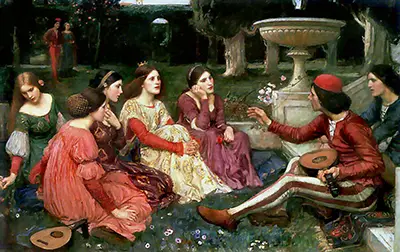Boccaccio's Decameron provides the direct inspiration for this painting. Waterhouse made use of literature and poetry for large amounts of his work, calling on mythological tales and local British literature in most cases. The male figure pictured here is telling various stories to the women that sit close by - they all appear enthused by his presentation, and his of music perhaps underlines the professional manner in which he delivers these lines. One can imagine these all being the children of high establishment figures as they enjoy some leisure time in a large private setting. Their attire is carefully selected and stunning, though not overly glamorous so as not to lose their innocence in our eyes. Behind them is a curated garden with fruit trees and a series of sculptured elements which produce a stunning setting in which these fortunate individuals can enjoy an opulent and privileged lifestyle.
The artist would practice these portraits individually, normally in pencil or chalk, before then placing them all together in the final painting. Although he would regularly make amendments directly on the canvas, he tried to limit these alterations by working hard in the preparation stage. Several study pieces for A Tale from the Decameron have been discovered, one of which was actually in oils itself, but with a far reduced use of detail in order to just plan out the layout for the main version shown here. One can examine this artist's oeuvre and discover various influences, though the most obvious would have to be the Pre-Raphaelite movement, and many still wrongly include him within this group. In actual fact, he arrived a little too late to be considered a genuine member but the similarities in style cannot be denied.
Lawrence Alma Tadema would work within a similar style to the earlier period of Waterhouse's career, where Neo-Classical influences of fashion, literature and architecture would all be present. Portaiture remained a key element of these paintings, but the background elements differed completely from how Waterhouse would work later in his career as he swapped marble floors for British foliage. Some of Alma Tadema's best contributions would be The Finding of Moses, The Roses of Heliogabalus and The Women of Amphissa and he chose to continue with this style through his career, even as it started to lose its popularity with the public. Although Dutch, he spent much of his life working in the UK and became very much a part of the artistic establishment there, achieving a strong following and large admiration for some of his best known work. These two were just a couple of contributors to a key period in British art history which remains highly thought of today.

